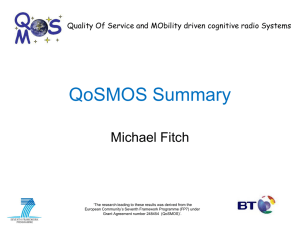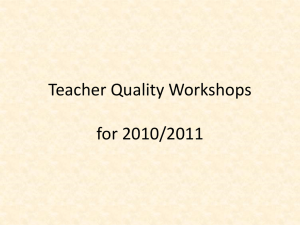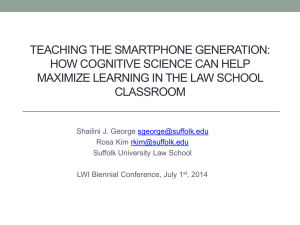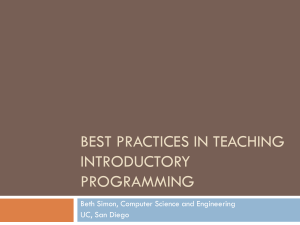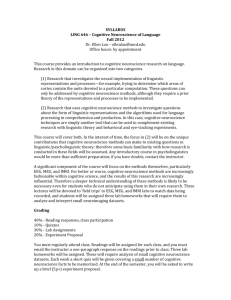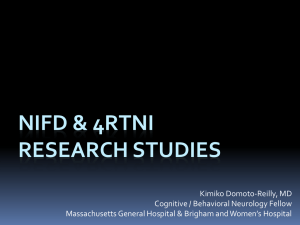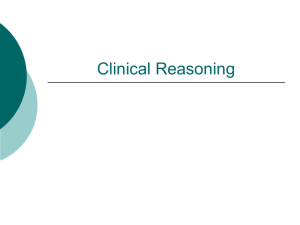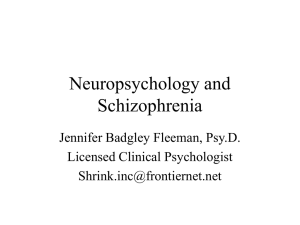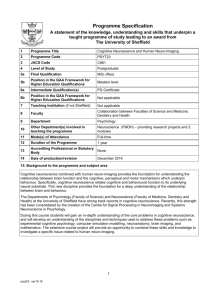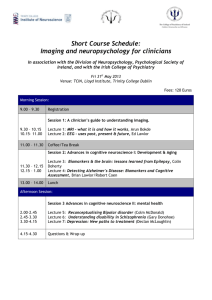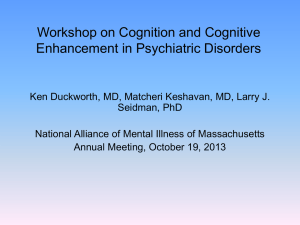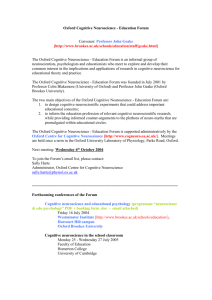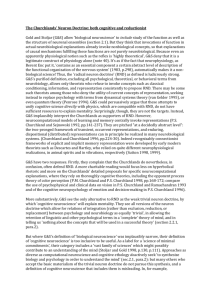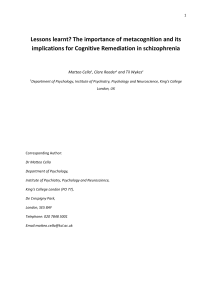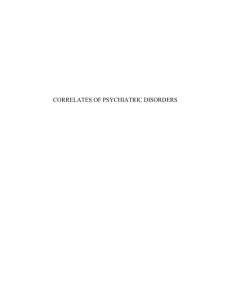Slide - KR
advertisement
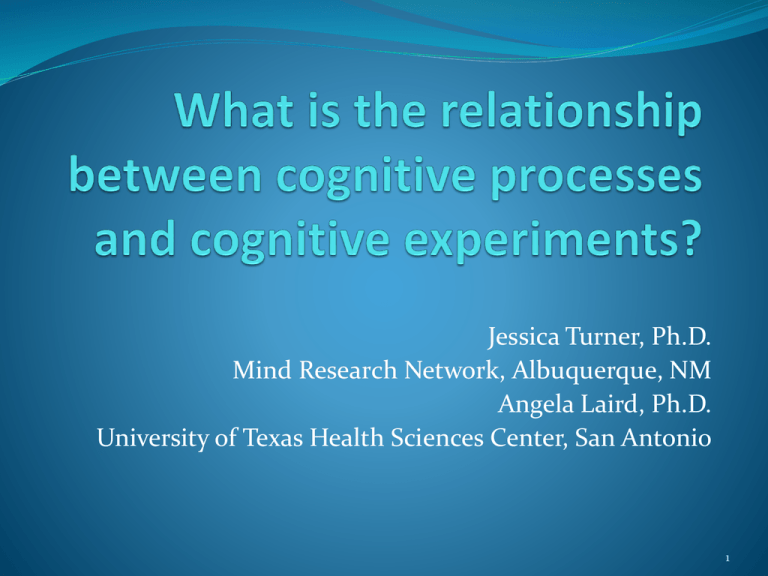
Jessica Turner, Ph.D. Mind Research Network, Albuquerque, NM Angela Laird, Ph.D. University of Texas Health Sciences Center, San Antonio 1 Conclusions Mental functions may be shorthand for complex neural circuitry and function; or they may be emergent properties which cannot be further deconstructed Either way we can build an ontology for them The link between experimental results and the mental function they claim to be “about” needs to be clarified Need details of time, location, assumptions, methods. Need to consider the hypothetical framework; the explicit operationalizations; the analyses done and not done; and the caveats from the experimental context. 2 I. Positive symptoms Delusions Hallucinations Disorganization II. Negative symptoms Blunted affect Few words (Alogia ) No initiative (Avolition ) No pleasure (Anhedonia) Social/occupational dysfunction Work/interpersonal relationships Self-care IV. Affective symptoms Discontent/depression (Dysphoria ) Suicidality Hopelessness III. Cognitive symptoms Attention Memory Executive functions (eg, abstraction) American Psychiatric Association. Diagnostic and Statistical Manual of Mental Disorders. Fourth ed. Text Revision. Washington DC: American Psychiatric Association. 2000. Slide courtesy of Dr. Jose Cañive 3 The ontological status of mental function over time Introspectionism Behaviorism Cognitive science 4 In the extremes Eliminative materialism Mental functions as concepts will disappear as we understand the brain better Reality is epiphenomena All we have is consciousness and everything else is a model 5 Cognitive Paradigm Approach The mental function experimenters claim to be studying is not as important as how they study it. 6 Schema for cognitive experiments BrainMap database: Experiments have conditions Describe the conditions of the experiment Stimulus Instructions Response And context: Pre/post treatment? Population studied? And behavioral domain 7 CogPO basics Turner and Laird, 2012. 8 BrainMap behavioral domains CogAtlas is similar Not complete Not clear which is which Not orthogonal 9 Linking mind and behavior Cognitive experiments attempt to measure mental processes Donders, 1869. 10 SZ have deficits detecting low spatial frequencies O’Donnell et al., J. Abnormal Psychology 2002. 11 Louis Wain (1860-1939) 12 Sz have attention problems Controls on average: 77% correct Sz on average: 54% correct Disentangling the roles of attention and perception in measuring perceptual thresholds is not easy to do. Carter et al., Schizophrenia Res. 2010 13 Linking mind and physiology Cognitive neuroscience experiments attempt to measure physiological correlates of behavior, indirectly connected to mental processes Attention: What is it? Endogenous (voluntary) attention vs Exogenous (involuntary) attention Posner: Experimental designs for studying voluntary attention The differences in speed and accuracy among these trials relates to voluntary control of attention 14 The spatiotemporal receptive-field map of a single neuron in the unattended mode (top) and attended mode (bottom). McAdams C J , Reid R C J. Neurosci. 2005;25:11023-11033 ©2005 by Society for Neuroscience Cognitive neuroimaging and mental function Localization of function Effort-related increases in signal 16 Cognitive neuroimaging and mental function Controls (L) and SZ (right) increases in BOLD signal for different attentional task conditions. Carter et al., Schizophrenia Res. 2010 17 Linking mind and brain Brain Map-supported analysis of “executive function” in schizophrenia Also known as “cognitive control” 41 papers with tasks including delayed match-to-sample or delayed response (including Sternberg item recognition), go/no-go (including AX-CPT), mental arithmetic, N-back, oddball, sequence recall, Stroop, Wisconsin Card Sort, and word generation tasks Minzenberg et al., Arch. Gen. Psychiatry, 2009 18 Linking mind and brain 19 From experiment to mental function Hypotheses Operationalization Analysis Interpretation 20 Hypotheses We frame hypotheses within a scientific framework. This rules out some questions as being silly E.g. we don’t ask about the olfactory role of primary visual areas But also keeps us from asking other questions Can we treat schizophrenia with cognitive training? 21 Operationalization This is a key step in linking what we are studying in the abstract to what we are measuring in reality Attention: Performance differences somehow capture what we mean by attention Perception: Sensory thresholds are defined as the 50% point or 75% point Executive function How many trials do you perseverate in using a rule you’re being told is wrong? 22 Analysis What we do with data is shaped by what we think is acceptable within our framework 23 Interpretation The caveats are important! These are plausible alternative explanations for the experiment Failures of operationalization Eg. A monkey who has figured out another way to get their juice reward or a human who is doing the study in some completely unexpected way The BOLD signal or other measurement is not sensitive to the differences you want Or it is sensitive to differences you don’t want (medication) 24 Cognitive neuroimaging and mental function Examples from fMRI It gets messy, when the linking hypotheses aren’t clear E.g. clinical populations: We know that the BOLD signal doesn’t look the same, and the behavior is different; but what does that mean about mental function per se? 25 Conclusions Science does not work solely by building on logical axioms. There is a theoretical framework behind the formation and interpretation of every experiment. How we think about the experimental design and interpretation is not context-free. Over time, concepts and relationships will disappear and new ones show up E.g., phlogiston, DNA as a blue print, arguments over nature vs nurture, the role of the unconscious in mental dysfunction. Our semantic framework for reasoning within cognitive neuroscience has to take that into account. 26 Conclusions How we characterize mental functions is going to change (again!). The results of cognitive experiments about mental function need to be subscripted by the experimental methods and theoretical framework. 27


